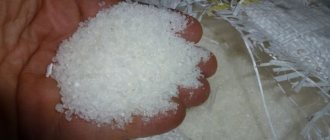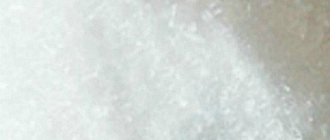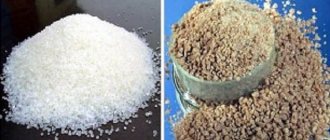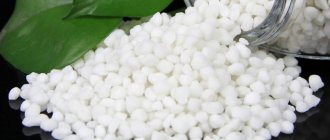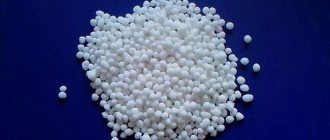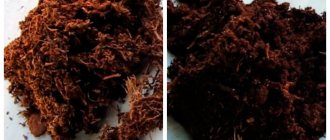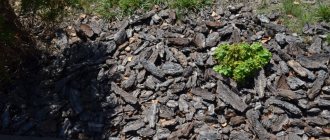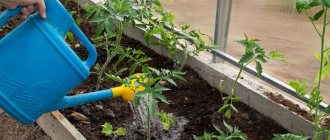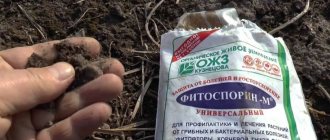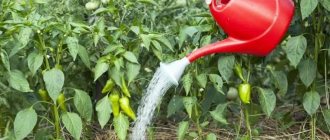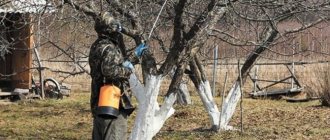Among the many ready-made soils for plants that are sold in any flower shop, hydrogel (also known as aqua soil and eco soil) causes the most questions and confusion.
What is hydrogel, why do we, flower growers, need it, how and where to use it - let’s try to figure it out.
A hydrogel is a polymer that has the unique ability to absorb and retain, when swollen, up to two liters of distilled water per 10 grams of hydrogel or about 0.11 liters of nutrient solution per 1 g of drug. The most common hydrogels are based on polyacrylamide. The hydrogel is non-toxic, absolutely sterile, and retains its properties at high and low temperatures in the soil for five years. In the end, the hydrogel is completely biodegradable - it breaks down into carbon dioxide, water and nitrogen. In our country, work on the creation of highly swelling polymer hydrogels began in the early eighties at the Institute of Chemical Physics of the USSR Academy of Sciences under the leadership of Professor K.S. Kazansky.
Polymers are substances whose molecules (macromolecules) consist of a large number of repeating units; The molecular weight of polymers can vary from several thousand to many millions. Special properties of polymers, such as: elasticity; low fragility of glassy and crystalline polymers; the ability of macromolecules to orient under the influence of a directed mechanical field; high solution viscosity at low polymer concentration; dissolution of the polymer through the swelling stage; the ability to dramatically change their physical and mechanical properties under the influence of small amounts of a reagent - allows them to be widely used in everyday life, mechanical engineering, the textile industry, agriculture and medicine, automobile and shipbuilding, and aircraft construction. The special properties of polymers are explained not only by their large molecular weight, but also by the fact that macromolecules have a chain structure and have a unique property for inanimate nature - flexibility.
SOCO Agricultural grade SAP, SOCO Chemical China.
Delivery from factory in China.
All of these hydrogels are designed specifically for agriculture to retain water and nutrients in outdoor soil, soil and potting mixes. They are superabsorbents (SAP), which are structured copolymers containing potassium compounds in their formula in an amount ranging from 18.3% for a Chinese hydrogel to more than 25% for a German hydrogel. At the same time, potassium performs the function of potassium fertilizer in a form convenient for digestion by the plant.
The superabsorbent is capable of absorbing water in quantities up to 500 times greater than its weight (in distilled water), while turning into gels that are insoluble in water. The superabsorbent consists of polymer chains with parallel and cross-links, resulting in the formation of a polymer network. When water comes into contact with one of these chains it is drawn into the molecule by osmosis and stored there. As the soil dries, the polymer releases up to 95% of the absorbed water.
The agricultural gel is capable of retaining large amounts of water and water-soluble fertilizers in doses recommended for plants, while retaining its properties in the soil for at least 5 years.
The best hydrogel in the world today is the Stokosorb 660 . The latest development of German chemists has received recognition among leading experts in the field of agricultural technologies. Stockosorb 660 is approved for use in organic farming as the safest. It complies with the strictest environmental standards of the European Union, the USA and the State of California. There are no restrictions on use and dosage.
Agricultural gels from France and China are not much inferior to German ones in their main indicators, have all the necessary international certificates and are supplied to all countries of the world without restrictions.
Our company has been working with soil moisture retention products since 2004. At the moment, from all the variety of manufacturers, we have selected the best and are selling 9 varieties of hydrogel from three reputable companies. Direct deliveries from manufacturing plants guarantee product quality. Having received products directly from the manufacturer, we also work directly with consumers, without using intermediaries in the form of representatives and distributors. Before entering the market and offering customers hydrogel from each manufacturer, we tested it at our sites, sites of scientific organizations and laboratories.
Therefore, all the information on our website is the result of the actual use of hydrogel in the conditions of central Russia, and not reprints from other sites. We have summarized all recommendations for the use of hydrogel in a table in the CONSUMPTION RATES . If you have questions about the use of hydrogel, we will always answer all your questions.
Considering that hydrogel is now beginning to be used on an ever larger scale, we strongly recommend that you be wary of fakes . a REFERENCE HYDROGEL SET from us . This set gives you the opportunity to visually see, touch and test hydrogel from the world's best manufacturers and will save your money and time.
The result of our own tests of various types of agricultural gels confirmed that only real high-quality products are capable of:
- Long-term increase in moisture reserves in soils and substrates
- Reduce watering frequency by at least 50%
- Ensure a uniform supply of water to the plant
- Reduce the removal of nutrients to the lower layers of soil
- Significantly reduce the cost of watering and fertilizers applied to the soil
- Get healthier plants
- Reduce ripening time
- Harvest more harvest
About hydrogel for soil and plants
Agricultural gel is a means for accumulating and retaining moisture in the soil. This is a moisture accumulator. It is also called plant conditioner or soil conditioner. Hydrogel is a polymer granule that, when soaked in water, swells and reaches a gel-like state. Moreover, the granules are able to absorb moisture during watering, from rain and even morning dew. When introduced into the root zone of plants, the hydrogel constantly nourishes the plant with water in the required quantities. The plant does not receive stress from changes in soil moisture and is 15-30% faster than control samples in development.
The hydrogel can be used outdoors, in greenhouses, flower pots and for indoor plants. In indoor pots, the use of hydrogel reduces the frequency of watering plants to one month. In flowerpots and designer compositions, the frequency of watering is reduced several times depending on the climate and location.
10 grams of dry superabsorbent can absorb 2 - 3 liters of rain or groundwater with fertilizers dissolved in it. At the same time, the intensity of fertilizer leaching is significantly reduced, since the fertilizers are stored in a polymer mesh and, as a result, are available to plants for a longer time. Due to this, productivity increases and ripening time is reduced.
The hydrogel works even after freezing and complete drying, without losing its properties. Does not lose its properties in the soil for up to 5 years, completely safe for plants and humans.
Principle of operation
In dry form, the hydrogel is a polymer granule. It is available in different modifications for different purposes of use. In the presence of moisture, the granules quickly swell to form a gel, while holding hundreds of times their weight in water and water-soluble substances (for example, fertilizers). In the soil, plant roots penetrate directly into the swollen polymer granules and feed from them.
What is it used for?
Plant water needs change during the growing season. For normal growth and development, they need a constant source of moisture and nutrients. The swollen polymer granules act as a reservoir of moisture and water-soluble fertilizers, from where they are consumed by plants as needed.
Brief technical information
- About 95% of water is in a form available to plants.
- Hydration - dehydration of granules is completely reversible.
- The polymer's shelf life in soil is more than 5 years.
- At the end of its service life, it completely decomposes into natural components with the release of carbon dioxide, water and potassium salts without the release of any toxic products.
- Complies with international quality standards - DIN EN ISO 9001, 14001.
- Non-toxic to plants and soil organisms.
- Not dangerous to humans and does not require personal protective equipment.
Economic effect
- Water savings reach 50%.
- Fertilizer use efficiency increases by almost 30%.
- The intervals between waterings are at least doubled.
- Soil cracking and erosion is prevented.
- The yield increases and the commercial quality of products improves.
Doses of application, methods of application
How to use hydrogel?
There are several areas of application of hydrogel in growing plants:
Germination of seeds
Grind the wet hydrogel until smooth and place it in a 3 cm thick layer on the bottom of a transparent container. Lightly press the seeds into the gel mass and cover the container with plastic wrap. Lift the film daily to remove condensation.
When using hydrogel, make sure that the granules do not spill onto the floor or garden path, otherwise there will be a risk of slipping on the swollen gel.
Growing seedlings
Add 1 part of dry hydrogel granules to 4 parts of soil and pour the soil mixture into the seedling containers, leaving 0.5-1 cm to the edge. Then sow the seeds for seedlings as usual, water them with water.
If you wish, you can sow the seeds directly into the prepared hydrogel, but in this case, in the cotyledon leaf phase, you will have to transplant the seedlings into the soil mixture. Do this carefully, without clearing the root of the granules.
Field of application of hydrogel
Agricultural hydrogel is suitable for use both in open ground (OG) and in protected ground - pots, containers, flowerpots, etc. It is successfully used in indoor floriculture. In OG - it becomes a huge help when laying lawns and alpine slides, planting trees, shrubs, and flower beds. A particularly visible effect of preserving water in hydrogel capsules is manifested when it is added to street and balcony containers. Often, watering 1-2 times a week in this case is sufficient to fully preserve the decorative effect of flower arrangements.
The swollen hydrogel is mixed with soil in planting containers.
The hydrogel has also found its application in growing seedlings, especially on an industrial scale. In seedling containers, the soil dries out very quickly, and the hydrogel allows you to slow down the process of final loss of moisture.
By mixing the hydrogel with soil in a seedling container, you can significantly speed up the development of seedlings.
Another interesting option is to germinate seeds in a hydrogel. The swollen granules are an excellent moisturized medium that stimulates the germination of seed sprouts.
Germination of seeds on hydrogel.
Pros and cons of the product
Like any plant care aid, hydrogel exhibits both positive and negative qualities.
Advantages and disadvantages
the powder allows you to maintain the loose structure of the soil, which promotes free growth of roots;
if the granules are impregnated with a nutrient composition, the plants will evenly receive beneficial nutrition for a long period;
seedlings planted in soil with gel germinate faster and develop better.
granules can become moldy under prolonged exposure to sunlight;
When using powder for growing house plants, you need to completely change the gel every 1.5-2 years.
The substance is not used for sprouting legumes and peas. You also need to take into account that it is impossible to grow plants on pure hydrogel.
See also
What is Bokashi and instructions for use, how to make it yourselfRead
Planting seedlings
Another convenient way to use hydrogel. This method is convenient for replanting seedlings of shrubs and trees.
Several handfuls of hydrogel swollen in water are placed in a hole dug under the seedling. Be sure to thoroughly mix the gel with the soil, and place the seedling on this ready-made mixture. All that remains is to level the hole with the seedling with soil.
If crystals are placed in the soil where the plant was planted and mixed with the soil, the granules will accumulate moisture and release it back during dry periods. And if the soil is too waterlogged, they will take the excess water onto themselves.
What plants is it suitable for?
The hydrogel is optimal for planting herbaceous crops. Among home crops, it is best to use powder or granules when growing chlorophytum, succulents, milkweed, ferns, Kalanchoe, dracaena, philodendrons, tradescantia, ivy, dieffenbachia, and ficus.
Plants placed in hydrogel are often not watered. To prevent the top layer of granules from drying out quickly, they are simply sprayed with a spray bottle. Flower pots should not be placed in areas exposed to bright sunlight, as the gel may “bloom.”
